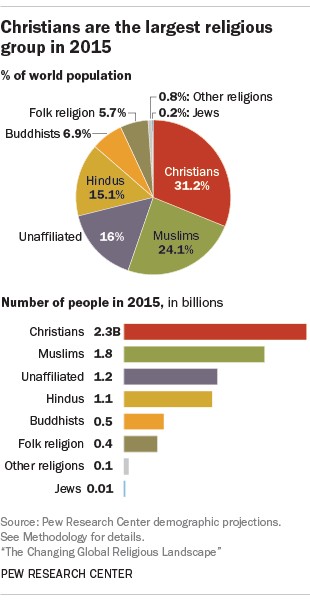The number of Muslims compared to Christians in the world is a subject of immense interest, and COMPARE.EDU.VN offers a detailed look into this global demographic landscape. While Christianity remains the world’s largest religion, the Muslim population is growing rapidly and is projected to nearly equal the Christian population by 2060, making understanding religious demographics and population projections crucial. Discover more insights on religious affiliation, fertility rates, and demographic trends on COMPARE.EDU.VN.
1. What Is The Current Global Population Of Muslims And Christians?
Currently, Christianity is the world’s largest religion, but Islam is catching up quickly. In 2015, Christians represented nearly a third (31%) of the global population of 7.3 billion, totaling approximately 2.26 billion people. Muslims followed with 1.8 billion people, accounting for 24% of the world’s population. These figures highlight the significant presence of both religious groups worldwide.
1.1 Detailed Breakdown of Global Religious Demographics
In 2015, other notable religious groups included the religiously unaffiliated, also known as “nones,” who comprised 16% of the global population. Hindus made up 15%, and Buddhists accounted for 7%. Adherents of folk religions, Jews, and members of other religions made up smaller percentages.
1.2 Projected Growth of Muslim and Christian Populations
Between 2015 and 2060, the global population is expected to increase by 32%, reaching 9.6 billion. During this period, the Muslim population, which has the youngest median age and highest fertility rate among major religious groups, is projected to increase by 70%. The Christian population is expected to grow by 34%, slightly faster than the global population but slower than the growth rate of Muslims.
1.3 Expected Convergence of Muslim and Christian Populations by 2060
By 2060, projections indicate that the Muslim population will reach 3.0 billion, or 31% of the total population, nearing the Christian population of 3.1 billion, or 32%. This convergence underscores the dynamic changes occurring in the global religious landscape.
2. What Are The Key Factors Influencing The Growth Rate Of Muslims And Christians?
Several factors influence the growth rates of religious populations, including fertility rates, age distribution, and religious switching. Understanding these elements provides insights into the projected demographic shifts between Muslims and Christians.
2.1 Fertility Rates
Muslims have the highest fertility rate among religious groups, averaging 2.9 children per woman, significantly above the replacement level of 2.1 needed to maintain a stable population. Christians have the second-highest fertility rate at 2.6 children per woman. Hindu and Jewish fertility rates are slightly below the global average of 2.4 children per woman, at 2.3 each.
2.2 Age Distribution
The age distribution within religious groups also plays a crucial role in population growth. Muslims have a median age of 24 years, and Hindus have a median age of 27 years, both younger than the global median age of 30. Christians have a median age of 30, matching the global median. Younger populations are more likely to have higher birth rates, contributing to faster population growth.
2.3 Religious Switching
Religious switching, or conversion, also impacts the size of religious groups. Between 2015 and 2020, Christianity is projected to experience the largest net losses due to switching. Approximately 5 million people are expected to become Christians, while 13 million are expected to leave Christianity, primarily joining the religiously unaffiliated.
2.4 Geographic Distribution
The geographic distribution of religious groups significantly affects their growth. Religions with many adherents in developing countries, where birth rates are high and infant mortality rates have been falling, are likely to grow quickly. Much of the growth of Islam and Christianity is expected to occur in sub-Saharan Africa.
3. How Do Birth Rates Compare Between Muslims And Christians?
Birth rates are a key indicator of population growth. Understanding the differences in birth rates between Muslims and Christians helps in projecting future population sizes and demographic trends.
3.1 Recent Birth Trends
In recent years, more babies were born to Christian mothers than to any other religious group. However, this trend is expected to change. Between 2010 and 2015, an estimated 33% of the world’s babies were born to Christian mothers, slightly higher than the Christian share of the world’s population in 2015 (31%). During the same period, births to Muslims made up an estimated 31% of all babies born worldwide, exceeding the Muslim share of the total population in 2015 (24%).
3.2 Projected Changes in Birth Rates
Globally, the relatively young population and high fertility rates of Muslims lead to a projection that between 2030 and 2035, there will be slightly more babies born to Muslims (225 million) than to Christians (224 million), even though the total Christian population will still be larger. By the 2055 to 2060 period, the birth gap between the two groups is expected to approach 6 million, with 232 million births among Muslims versus 226 million births among Christians.
3.3 Impact of Declining Birth Rates Among the Unaffiliated
In contrast to the growth in births among Muslims and Christians, people who do not identify with any religion are experiencing a different trend. While religiously unaffiliated people currently make up 16% of the global population, only an estimated 10% of the world’s newborns between 2010 and 2015 were born to religiously unaffiliated mothers. By 2055 to 2060, just 9% of all babies will be born to religiously unaffiliated women, while more than seven-in-ten will be born to either Muslims (36%) or Christians (35%).
4. What Role Does Geographic Location Play In The Distribution Of Muslims And Christians?
Geographic location is a significant factor in the distribution and growth of religious populations. Different regions exhibit varying trends in fertility, mortality, and religious switching, impacting the overall demographic landscape.
4.1 Regional Distribution of Christians
The share of Christians worldwide who live in sub-Saharan Africa is expected to increase dramatically between 2015 and 2060, from 26% to 42%, due to high fertility in the region. Meanwhile, religious switching and lower fertility will drive down the shares of the global Christian population living in Europe and North America.
4.2 Regional Distribution of Muslims
Sub-Saharan Africa is also expected to be home to a growing share of the world’s Muslims. By 2060, 27% of the global Muslim population is projected to be living in the region, up from 16% in 2015. By contrast, the share of Muslims living in the Asia-Pacific region is expected to decline over the same period, from 61% to 50%. The share of Muslims in the Middle East and North Africa is expected to remain steady at 20%.
4.3 Geographic Concentrations and Demographic Challenges
The religiously unaffiliated population is heavily concentrated in regions with aging populations and low fertility, such as China, Japan, Europe, and North America. In contrast, religions with many adherents in developing countries, where birth rates are high, are likely to grow quickly. This geographic disparity contributes to the projected decline in the share of the unaffiliated population globally.
5. How Do Death Rates Affect The Population Growth Of Muslims And Christians?
Death rates, along with birth rates, significantly impact the natural increase of religious populations. Understanding these trends provides insights into the demographic challenges and opportunities faced by Muslims and Christians.
5.1 Christian Death Rates
In recent years, Christians have had a disproportionately large share of the world’s deaths (37%), largely due to the relatively advanced age of Christian populations in some regions. This is especially true in Europe, where deaths are estimated to exceed births among Christians. In Germany alone, there were an estimated 1.4 million more Christian deaths than births between 2010 and 2015, a pattern that is expected to continue across much of Europe in the coming decades.
5.2 Muslim Death Rates
Muslims have a relatively small number of deaths (61 million) compared to the number of births (213 million) between 2010 and 2015. This large natural increase results from both high Muslim fertility and the concentration of the Muslim population in younger age groups, which have lower mortality rates.
5.3 Projected Changes in Death Rates
The number of deaths is projected to increase for all religious groups between 2015 and 2060 as the world’s population continues to grow and age. However, the impact will vary across regions. For example, Christian deaths are expected to outnumber births in Europe and, by around 2050, in North America, signaling that much of Christianity’s future growth is likely to be in the global South, particularly in sub-Saharan Africa.
6. What Are The Projections For The Religiously Unaffiliated Population?
The religiously unaffiliated population, often referred to as “nones,” includes atheists, agnostics, and those who do not identify with any particular religion. Understanding the demographic trends and projections for this group provides a comprehensive view of the global religious landscape.
6.1 Current Size and Distribution
In 2015, there were slightly fewer than 1.2 billion atheists, agnostics, and people who did not identify with any particular religion around the world, representing 16% of the global population. The religiously unaffiliated population is heavily concentrated in regions with aging populations and low fertility, such as China, Japan, Europe, and North America.
6.2 Projected Decline as a Percentage of Global Population
By 2060, the unaffiliated population is expected to reach 1.2 billion, but as a share of the total global population, they are projected to decline from 16% in 2015 to 13% in 2060. While the unaffiliated are expected to continue to increase as a share of the population in much of Europe and North America, they will decline as a share of the population in Asia, where 75% of the world’s religious “nones” live.
6.3 Demographic Challenges
The religiously unaffiliated population faces demographic challenges such as low fertility rates and an older age profile. Between 2015 and 2020, the total fertility rate for religiously unaffiliated women is projected to be 1.6 children per woman, nearly a full child less than the rate of 2.5 children per woman for religiously affiliated women. In 2015, the global median age for the female unaffiliated population was 36, compared with 30 for the religiously affiliated.
7. How Does Religious Switching Influence Population Numbers?
Religious switching, the process of individuals changing their religious affiliation, plays a notable role in shaping the demographic landscape of religious groups. Understanding the patterns and impact of religious switching is crucial for accurate population projections.
7.1 Switching Patterns
Between 2015 and 2020, Christians are projected to experience the largest losses due to switching. Globally, about 5 million people are expected to become Christians, while 13 million are expected to leave Christianity, with most of these departures joining the ranks of the religiously unaffiliated.
7.2 Impact on the Unaffiliated
The unaffiliated are projected to add 12 million and lose 4.6 million via switching, for a net gain of 7.6 million between 2015 and 2020. This gain is primarily due to people leaving Christianity and other religious groups.
7.3 Regional Differences
Religious switching patterns vary significantly by region. In Europe, North America, Australia, and New Zealand, religious disaffiliation is common, contributing to the growth of the unaffiliated population in these regions.
8. What Can Be Inferred From The Data About Future Global Religious Trends?
The available data provides valuable insights into future global religious trends, including the growth of Islam, the continued presence of Christianity, and the challenges faced by the religiously unaffiliated population.
8.1 Projected Growth of Islam
Islam is projected to be the world’s fastest-growing major religious group in the decades ahead. The relatively young population and high fertility rates of Muslims lead to a projection that by 2060, the Muslim population will nearly equal the Christian population. Much of the growth of Islam is expected to take place in sub-Saharan Africa.
8.2 Continued Presence of Christianity
Christianity is expected to remain the world’s largest religion, although its growth rate is slower than that of Islam. By 2060, the Christian population is projected to reach 3.1 billion, or 32% of the global population. However, regional shifts are expected, with a growing share of Christians living in sub-Saharan Africa.
8.3 Challenges for the Unaffiliated
Despite gains through religious switching, the religiously unaffiliated population is projected to decline as a percentage of the global population due to low fertility rates and an older age profile. This decline is heavily influenced by the situation in Asia, particularly China, which is home to a majority of the world’s unaffiliated population.
9. How Do Perceptions About Global Religious Group Sizes Compare To The Projections?
Perceptions about the size and future growth of religious groups can differ from demographic projections. Understanding these discrepancies provides insights into public awareness and potential misconceptions.
9.1 American Perceptions
Before releasing projections of the future size of religious groups in 2015, Pew Research Center surveyed Americans about their perceptions of the global religious landscape. About half of Americans (52%) correctly identified Christians as the largest religious group, while a quarter incorrectly believed that Muslims were the largest.
9.2 Expectations for the Unaffiliated
Most Americans (62%) predicted that the global share of religious “nones” would increase between now and 2050, an expectation potentially influenced by trends in the U.S. However, projections indicate that the global unaffiliated population will decline as a share of the global population.
9.3 Expectations About the Largest Group in 2050
When asked which group they expected to have the most adherents globally in 2050, Americans were divided among those who said religious “nones” (33%), Christians (32%), and Muslims (29%). These expectations varied by age, religion, and political affiliation, highlighting the diverse perceptions of the future religious landscape.
10. What Are The Implications Of These Trends For The Future?
The trends in religious demographics have significant implications for the future, affecting social, political, and economic landscapes globally.
10.1 Social and Cultural Implications
Changes in the size and distribution of religious groups can influence social norms, cultural values, and intergroup relations. Understanding these shifts is crucial for promoting tolerance, managing diversity, and fostering social cohesion.
10.2 Political Implications
Religious demographics can also impact political dynamics, influencing voting patterns, policy debates, and international relations. Policymakers need to be aware of these trends to address the needs of diverse populations and promote inclusive governance.
10.3 Economic Implications
Religious affiliation can influence economic behavior, including consumption patterns, charitable giving, and labor market participation. Understanding these relationships can help economists and businesses make informed decisions and develop targeted strategies.
In conclusion, the global religious landscape is dynamic and constantly evolving. While Christianity remains the largest religion, Islam is growing rapidly and is projected to nearly equal the Christian population by 2060. Factors such as fertility rates, age distribution, religious switching, and geographic location play crucial roles in shaping these trends. The religiously unaffiliated population faces demographic challenges, and perceptions about the future size of religious groups can differ from demographic projections. These trends have significant implications for the future, affecting social, political, and economic landscapes globally.
For more detailed comparisons and insights, visit COMPARE.EDU.VN, where we provide comprehensive analyses to help you make informed decisions.
Navigating the complexities of religious demographics can be challenging. At COMPARE.EDU.VN, we offer comprehensive and objective comparisons to help you understand these trends and make informed decisions. Whether you are interested in population projections, religious affiliations, or demographic shifts, our resources provide valuable insights.
Don’t let information overload hinder your decision-making process. Visit COMPARE.EDU.VN today and discover how we can assist you in making sense of complex comparisons.
Contact Us:
Address: 333 Comparison Plaza, Choice City, CA 90210, United States
Whatsapp: +1 (626) 555-9090
Website: compare.edu.vn
Frequently Asked Questions (FAQs)
1. How many Christians are there in the world compared to Muslims?
- In 2015, there were approximately 2.26 billion Christians and 1.8 billion Muslims worldwide.
2. Which religion is growing faster, Christianity or Islam?
- Islam is projected to grow faster than Christianity in the coming decades.
3. What is the projected Muslim population by 2060?
- By 2060, the Muslim population is projected to reach 3.0 billion.
4. What is the projected Christian population by 2060?
- By 2060, the Christian population is projected to reach 3.1 billion.
5. What factors contribute to the growth of the Muslim population?
- High fertility rates and a young population contribute to the growth of the Muslim population.
6. What is the fertility rate among Muslims?
- The fertility rate among Muslims is 2.9 children per woman.
7. How does religious switching affect the Christian population?
- Religious switching is projected to cause net losses in the Christian population between 2015 and 2020.
8. Where is most of the growth in Islam expected to occur?
- Most of the growth in Islam is expected to occur in sub-Saharan Africa.
9. What challenges does the religiously unaffiliated population face?
- The religiously unaffiliated population faces challenges such as low fertility rates and an older age profile.
10. How do perceptions of global religious group sizes compare to projections?
- Perceptions can differ, with many Americans believing that the religiously unaffiliated will increase, while projections indicate they will decline as a percentage of the global population.


